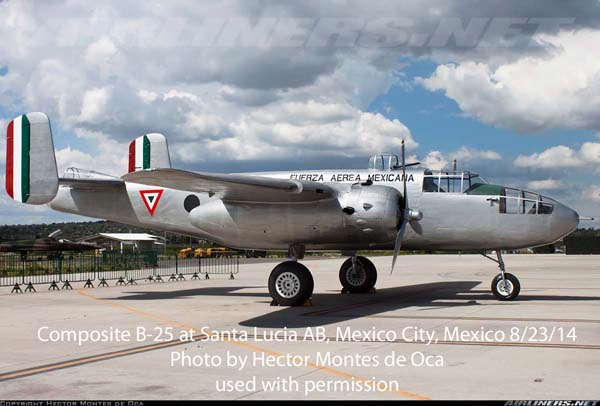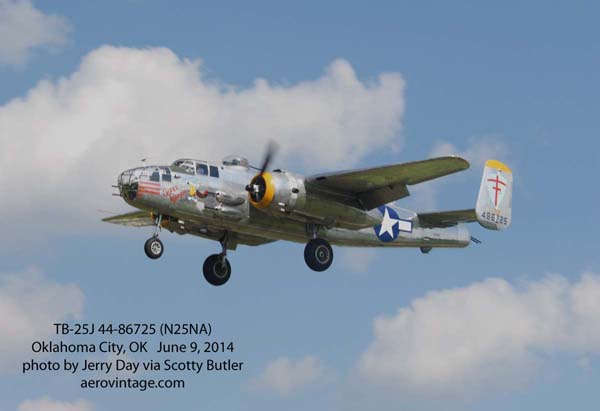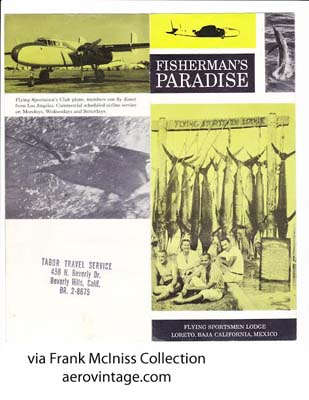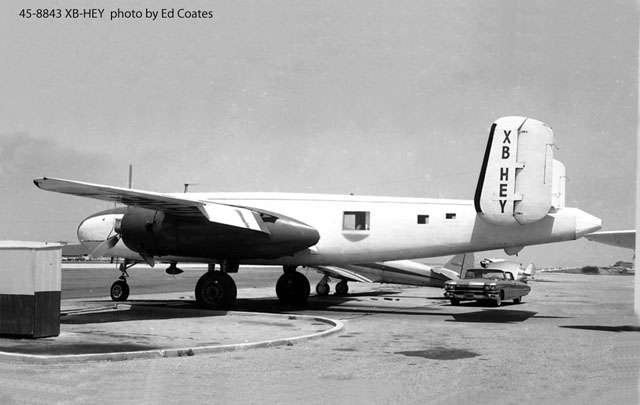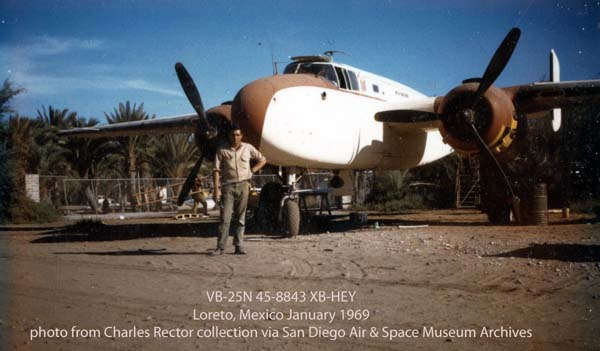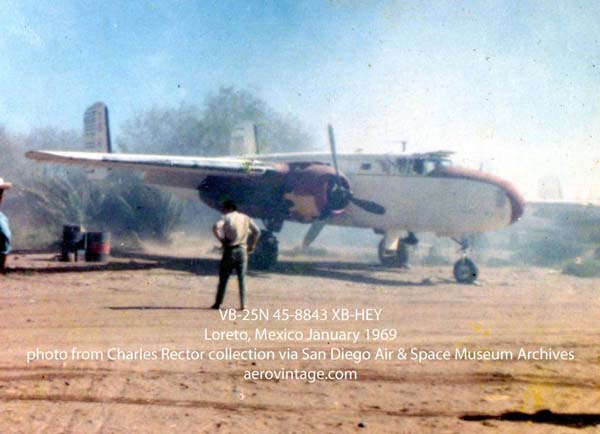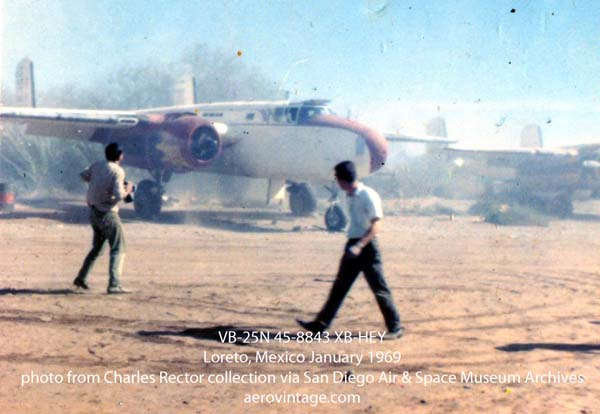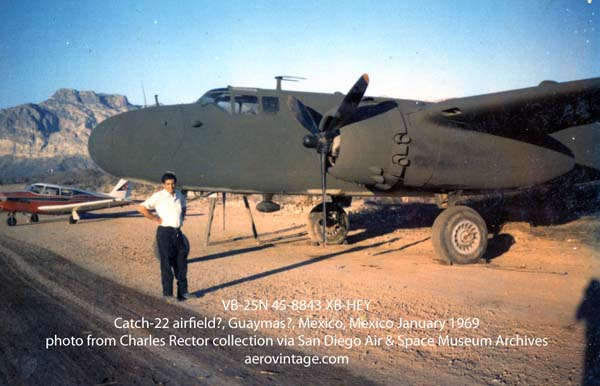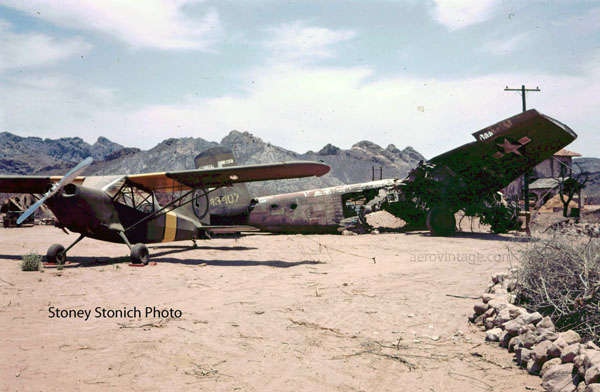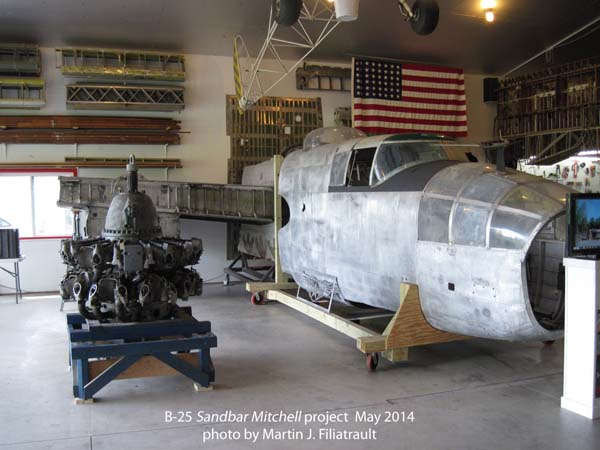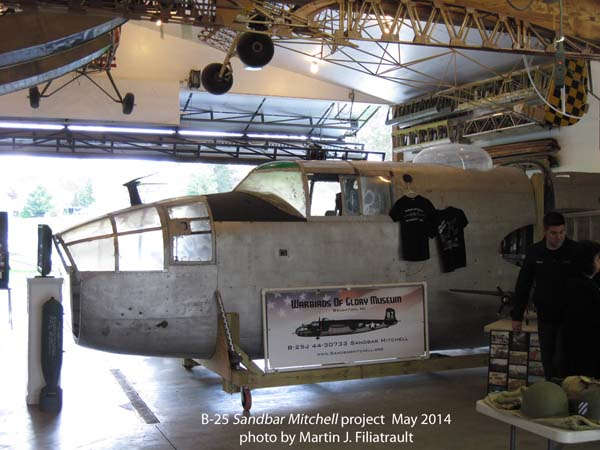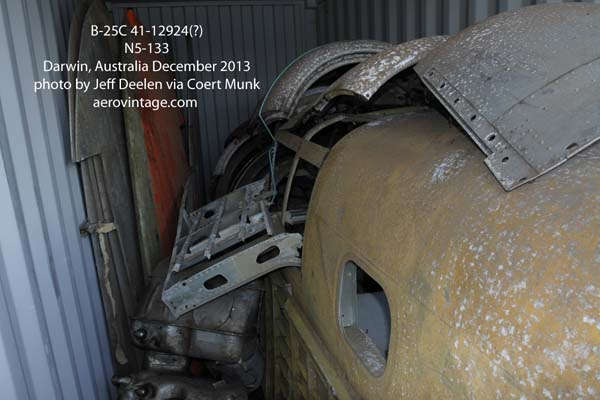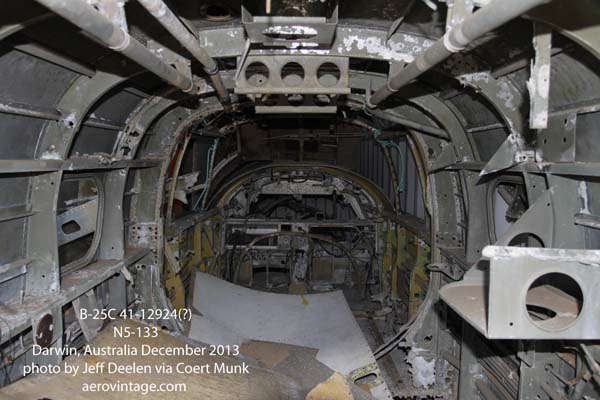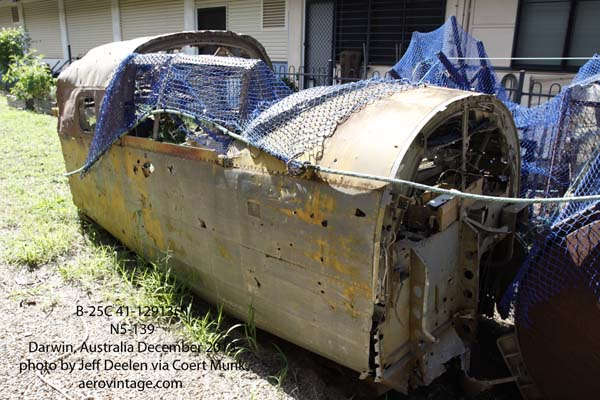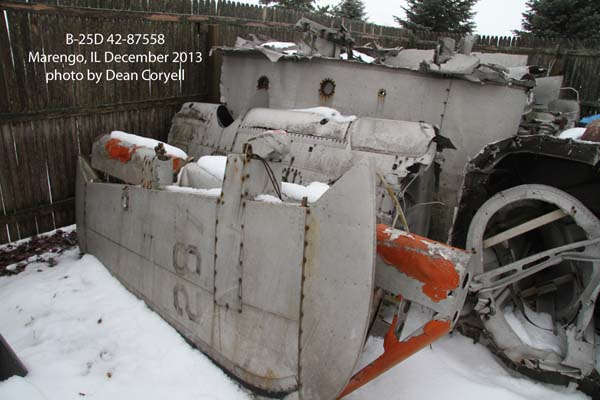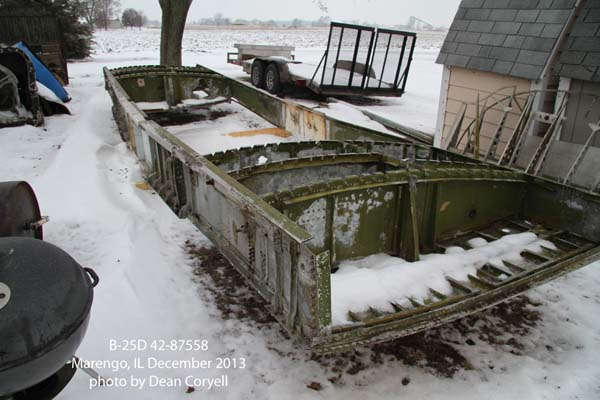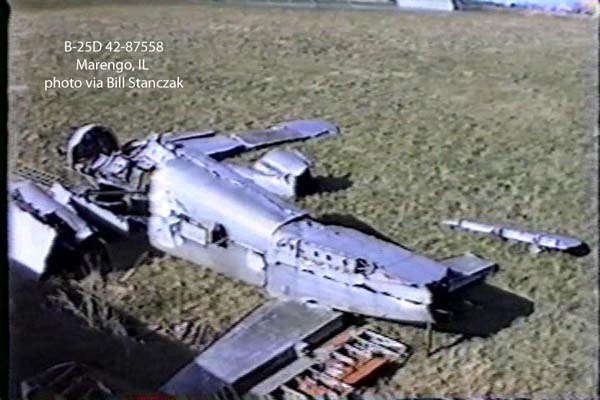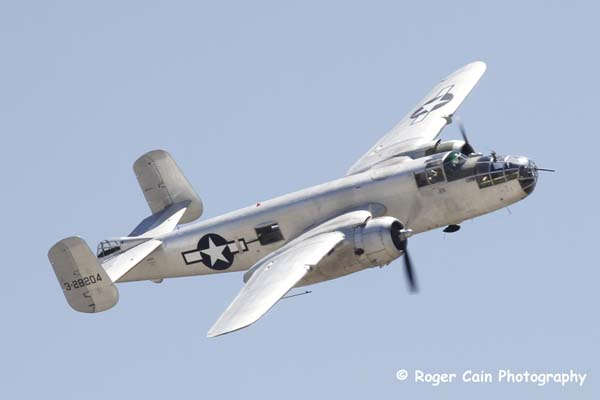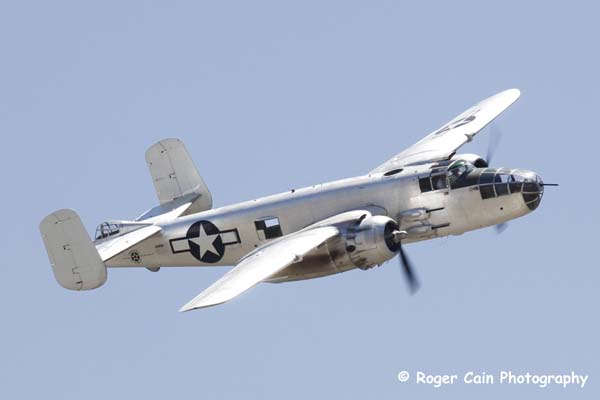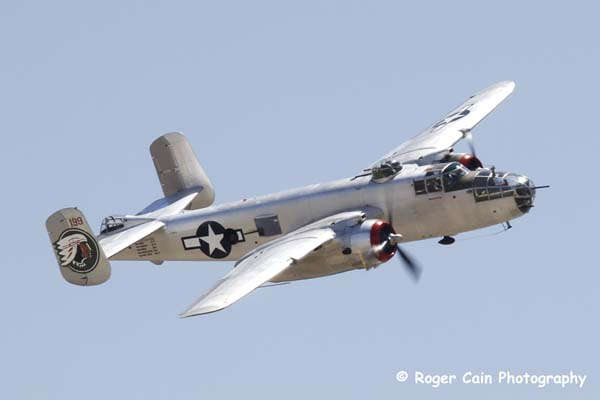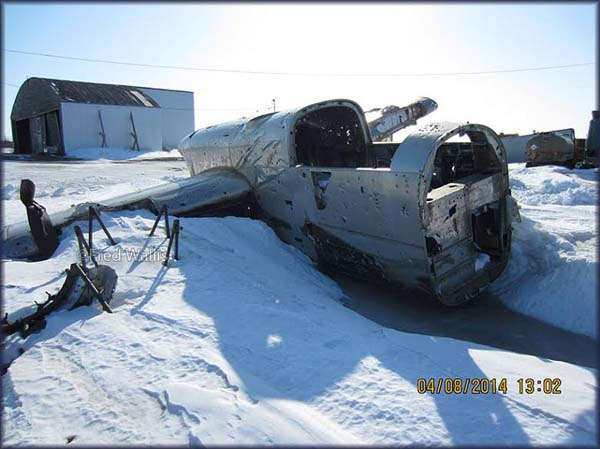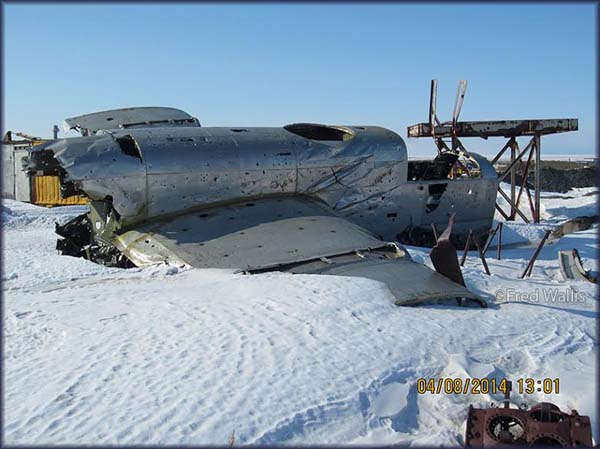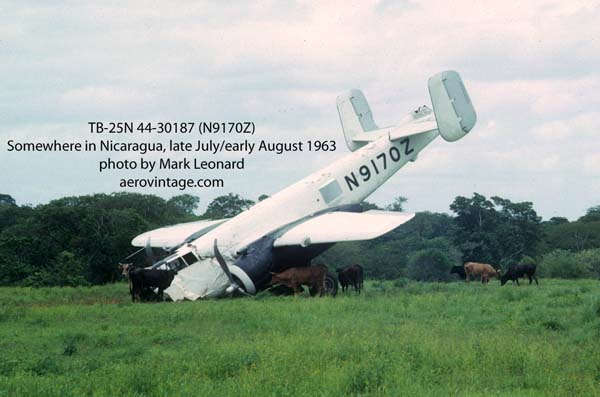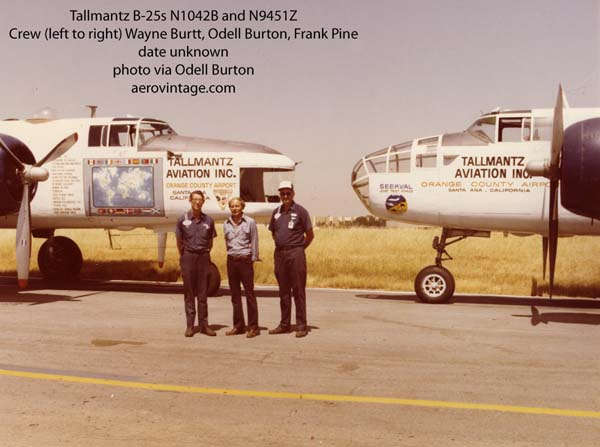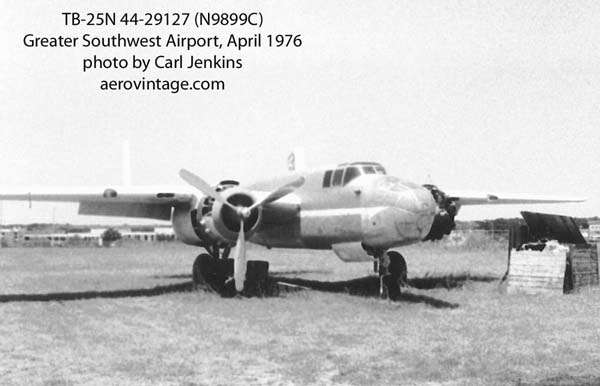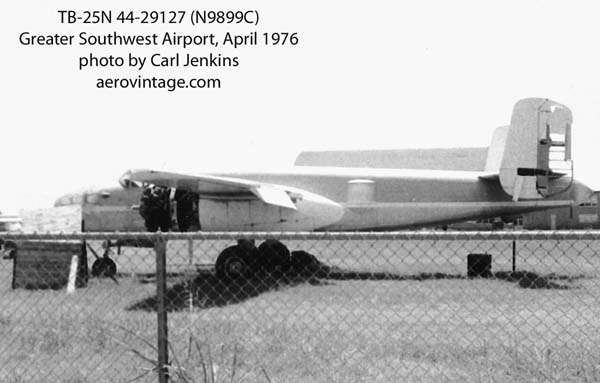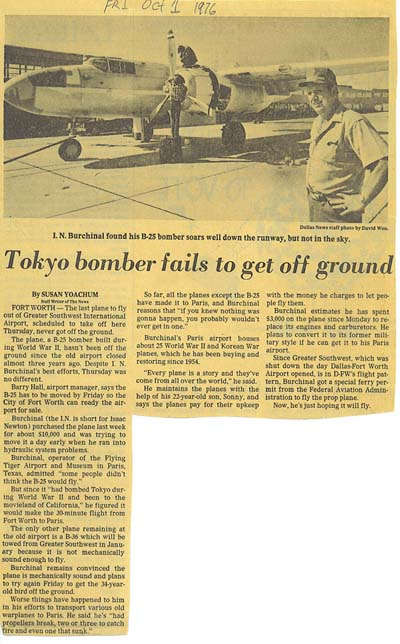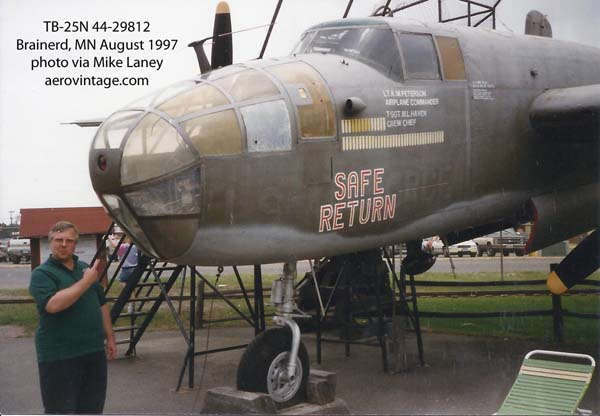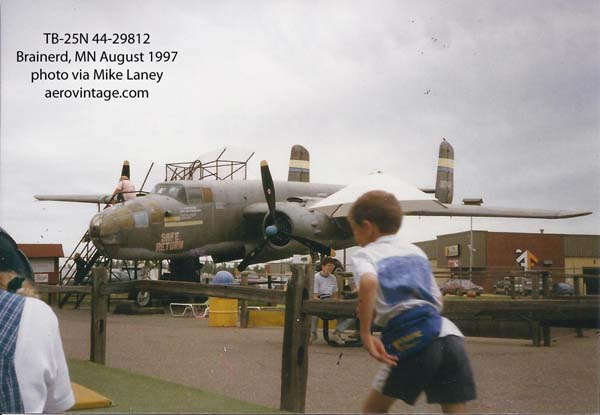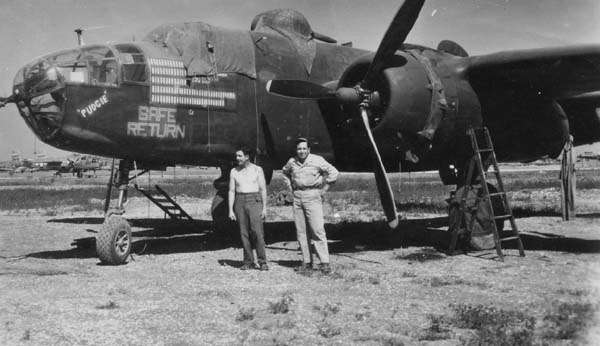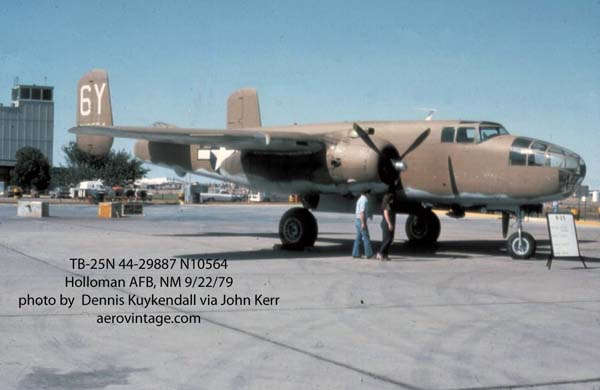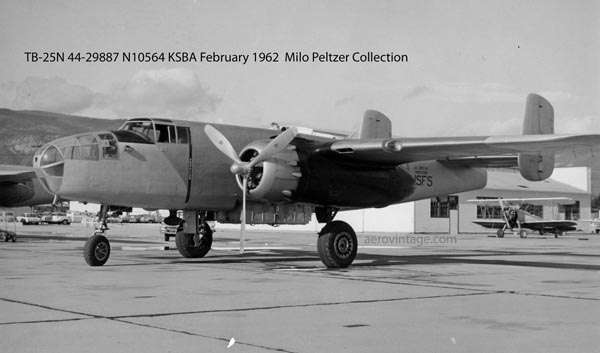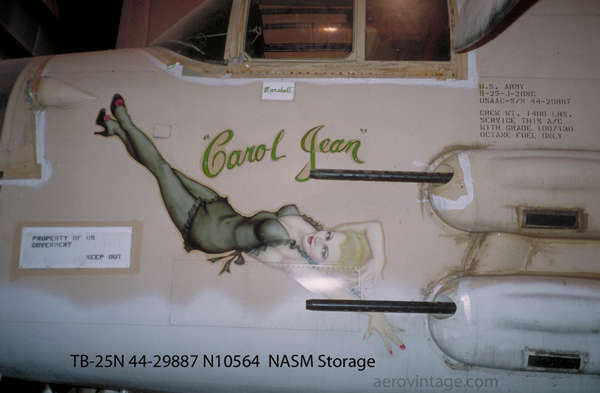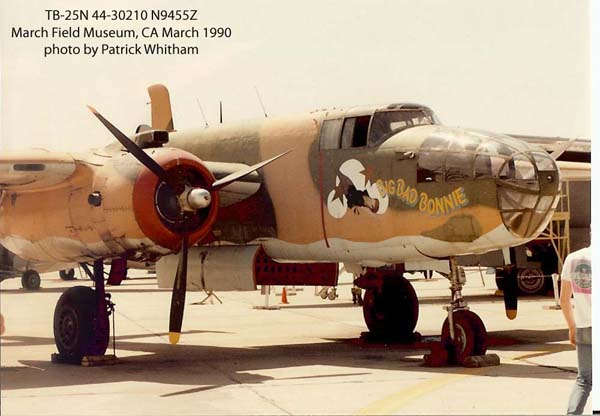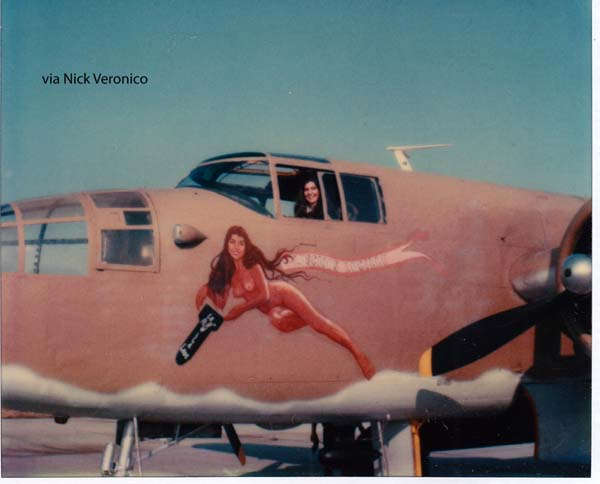AERO VINTAGE BOOKS
2014 B-25 NEWS
B-25 News Archive
Current B-25 News
2017 B-25 News
2016 B-25 News
2015 B-25 News
2014 B-25 News
2013 B-25 News
2012 B-25 News
2011 B-25 News
2010 B-25 News
2009 B-25 News
2008 B-25 News
2007 B-25 News
2006 B-25 News
2005 B-25 News
2004 B-25 News
1999-2003 B-25 News
Back to B-25 InformationBack to the Main Page
We're including these pages as an update point for B-25 news. We'll post information garnered from any variety of sources, and notate that source at the end of the item. If anyone has anything they'd like to add, please let us know.
December 2014
- Mexican Mitchell: The Rest of the Story: A bit of follow up to what was reported last month on the two Mexican B-25s, TB-25N 44-29145 (N9877C) and TB-25K 44-30692 (N9623C), that have been rebuilt into a static B-25J for eventual display. Hector Montes de Oca, the photographer of the B-25 at the Santa Lucia Air Base near Mexico City on August 23, 2014, added the following information in an email to me:
I have been trying to reveal the dark secrets behind our polemic B-25. I have established contact with a general who is in charge of the military museum inside the air base at Santa Lucia. Also he has worked on the restoration of the frame and has answered many of my questions. Let me say that Aad's theory about the plane is now 100% correct (I read it on your site), good work indeed. Here is what he has told me so far:
The frame was a restoration made of two B-25s: B-25N 44-29145 (N9877C) and B-25K 44-30692 (N9623C). Both airplanes were manufactured and delivered circa 1944 in the U.S. N9877C was assigned to the Twelfth Air Force in Italy but after a year, the plane returned to the US. Then, in 1945 both airplanes were assigned to different air bases in the US.
N9623C was converted to fire tanker in May 1961 and fitted with 1,280 gallon tank. In 1961 the plane was operated by Sonora Flying Service and was registered with the known registration.
On the other side N9877C was registered and flown by Aviation Rental Service from 1958-1961.
As civil aircraft, both were together since 1965 when they were offered for sale by Allied Aircraft Sales in Phoenix. The same year, both were purchased by the International Civil Aviation Organization and sent to Civil Aviation Training Centre in Mexico City. Then donated to the Mexico City's government in 1985 and placed on display in a park called 'San Juan de Aragón'. Unfortunately they were there in poor conditions, N9877C's complete tail was stolen, both frames had empty cockpits (any instrument was left) and were painted inside and outside with graffiti.
The restoration of this B-25K begins with the salvage of these pair from the park. In the first instance the 4th Maintenance Echelon at Santa Lucia air base made an inner structure and several pieces to complete the fuselage (taken from N9623C) to stand up the entire plane. Also they joined the whole wings and the engines coming from N9877C. At the moment they have fitted it with many machine guns, located on the upper and rear side. They are now working on a transparent nose for the plane. This B-25 will be displayed inside the museum located at the air base and in the future aerial shows as a static element.
So, I think this is pretty definitive on what happened to these two airframes and where their (its) future will lie.
November 2014
- Mantz B-25 Fate Finally Established: The fate of the B-25H that Hollywood Pilot Paul Mantz used for two decades to establish himself as the king of aerial filming had finally been determined with some certainty. Two years after it was sold by Tallmantz Aviation, B-25H 43-4346 (N1203) crashed near Santa Marta, Colombia, on September 4, 1976, and was presumably very badly damaged or destroyed. At least one person aboard the aircraft when it crashed was killed. At that time, Santa Marta was the center of the Colombian marijuana industry and a small air force of rag tag aircraft were used to smuggle 'Colombian Gold' north to the U.S. All indications would suggest that this B-25H was used as part of that effort.
As a quick recap, Paul Mantz obtained the B-25 in 1946 when he bought up a field of surplus airplanes at Stillwater, Oklahoma. He had most scrapped, but saved, among others, the B-25H and two P-51Cs, registered as NX1202 (P-51C), N1203 (B-25H), and NX1204 (P-51C). The B-25H was developed into a useful cameraship, particularly when the nose compartment was modified to accept the three bulky cameras of the Cinerama film process.
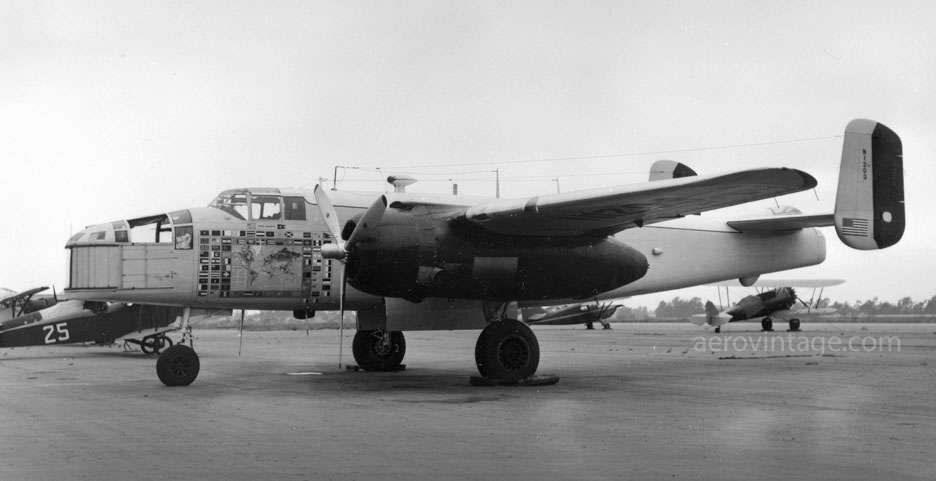
It was used extensively through the 1950s and early 1960s to film numerous Cinerama features and a number of Walt Disney CircleVision projects, as well as countless other Hollywood productions. Mantz and, later, Tallmantz, continued to utilize the B-25H but early 1970s, the tired B-25H was replaced by Tallmantz TB-25N 44-30493 (N9451Z). N1203 was let out to pasture, as it were According to the FAA registration file, it was sold by Tallmantz to Howard Stucky and Lawrence Leang of Moundridge, Kansas, in July 1975. It was sold in March 1976 to Leroy Sansom, of Burbank, California, then transferred immediately back to Stucky and Leang. It was, that same month, then sold to Vicki Meller, also of Burbank, California. Nothing is known of any of these owners and what would be appear to be a confusing series of owners over a short time.
In 1976, the airplane was observed operating from Van Nuys airport with most of its Tallmantz markings intact, save for the name "Talisman Aviation" inscribed on the nose. Then, it disappeared from sight, with rumors abounding that it was being used for drug smuggling and crashed in Colombia.
Well, it turns out the rumors were at least partly true. It did crash at Santa Marta, Columbia, on the north coast of the country, on September 4, 1976. The source of this information are unclassified State Department cables that have surfaced through the WikiLeaks website. I'm not a big fan of WikiLeaks or the process of exposing state secrets, but for what it is worth, the fate of this B-25 is now pretty much nailed down.
The salient points of the first cable, sent September 17, 1976, was recorded as having been sent directly to the registered owner of the B-25, Vicki Meller, and requests:
DEPARTMENT OF STATE IS ATTEMPTING TO LOCATE THE OWNER OF AIRCRAFT B-25 REGISTRATION NO. N-1203 WHICH WAS REPORTED CRASHED IN SANTA MARTA, COLUMBIA SEPTEMBER 4 AND THE NEXT- OF-KIN OF A VICTIM OF THE CRASH EDDIE ISSAIC.
So, based on this, we have a crash victim named Eddie Issaic. Spelling might not be correct of his last name, but that is the content of the cable.
A second pertinent cable was sent four days later, and gives additional information:
1. DEPARTMENT CONTACTED MILTON STOLLACK WHO STATED HE AND MELLER SOLD AIRCRAFT B-25 TO JOHN GOODSON, ANHAUSER CORPO- RATION, N.Y. IN JULY 1976 AND DOES NOT KNOW EDDIE ISSAIC. FAA HAS NO RECORD OF TRANSFER OF AIRCRAFT TO NEW OWNER AND IS CHECKING FURTHER.
2. DEPARTMENT UNABLE TO LOCATE ANHAUSER CORPORATION, N.Y. AND ANHAUSER BUSCH (ONLY SIMILAR NAMED CORPORATION LISTED IN N.Y. DIRECTORY) KNOWS NOTHING OF GOODSON OR B-25.
3. DEPARTMENT WILL KEEP POST INFORMED IF ANY FURTHER INFO BECOMES AVAILABLE.
From this, we learn that apparently Milton Stollack owned N1203 with Meller, and he states they sold the B-25H to John Goodson of Anhauser Corp. in July 1976. As noted, no record of this sale was processed to the FAA.
Stollack is, presumably, the same Milt Stollack who, as an air tanker pilot, was killed in a 2002 PB4Y-2 air tanker accident in Colorado.
An internet search of what was going on in the Santa Marta region of Colombia during this period in the 1970s reveals a thriving drug smuggling industry using a variety of aircraft to move marijuana from Colombia to the U.S., flying from unimproved airstrips in the remote mountains in the area. It doesn't take much of a stretch to presume N1203 was lost being used as such, with the loss of at least one crewman on board at the time.
Such an internet search has uncovered nothing of Eddie Issaic or John Goodson, and little of Vicki Meller other than her name was listed as the registered owner of two B-25s at the time, N1203 and TB-25N 44-30535 (N9462Z). We shall await further details of the accident and what became of the remains of this historic B-25. Thanks to Bryan Oliver for uncovering this little tidbit of information and passing it along.
- Mexican B-25 Emerges From Restoration: A pair of derelict Mexican B-25s that were nominally on display in a park in Mexico City until 2012 have apparently been combined into one airframe and undergone an impressive restoration by a Mexican Air Force unit. This photo, taken by Hector Montes de Oca at Santa Lucia Air Base near Mexico City on August 23, 2014, is used with permission.
For good measure, here is the Airlners link to the posted photo.
The pair of derelict Mexican B-25s have been mentioned several times over the past near two decades of B-25 News, and these two aircraft are circumstantially believed to be TB-25N 44-29145 (N9877C) and TB-25K 44-30692 (N9623C). Both B-25s, as civil aircraft, were purchased by the International Civil Aviation Organization in 1965 and sent to Civil Aviation Training Center in Mexico City. When and how and why they ended up in the park is a bit of a mystery, but contributor Aad van der Voet provided me with these details recently, along with the head's up on the photo.
He writes:
The park where they were displayed was the Bosque de San Juan de Aragón. The duo was still visible there in Google Earth satellite imagery from July 2010 (at coordinates 19.4609N 99.0775W), but they are no longer there in imagery from April 2012. In other words, they were removed from the park circa 2011. They were moved to Santa Lucia Air Base, 23 miles north of Mexico City, for restoration (rebuild) to static display condition by the 4/o. Escalón de Mantenimiento de Material Aéreo (4th Maintenance Echelon) of the Mexican Air Force. These guys do most of the restoration work for the Museo Militar de Aviacíon, which is also located at Santa Lucia Air Base and has aircraft on static display on various locations at the base. It was likely therefore that a B-25 would eventually show up at the base, which would then be a composite airframe, restored from sections of both aircraft.
The photographer uploaded it as "BMM-3502", but the photo shows that it does not (yet) carry that serial. Of course the real BMM-3502 was B-25J 44-86718 (fate unknown to me), but it has not been sighted for more than 50 years, so it's highly unlikely that this aircraft is the real one. In fact I cannot find any other suitable candidate for this aircraft, so I think this beautiful B-25 must be the amazing result of the restoration work done on 44-30692 (N9623C) and 44-29145 (N9877C) at Santa Lucia air base.
If so, compare this result to some photos I found of duo when they were still in the park in Mexico City (see attached, the one marked as "XL-7" is N9623C and is missing its rear fuselage and tail section). As you can see, they were little more than wrecks then.
As you probably know, the identities of these aircraft are widely quoted as 44-30692 (N9623C) and 44-29145 (N9877C). Let's assume for now that this is correct, although it was never confirmed as far as I know. The aircraft marked as "XL-7" is always quoted as N9623C, and this is also what I reported to you yesterday.
However, your remark about the B-25K radar nose on one aircraft prompted me to have a closer look. I compared the photos of the derelict wreck of "XL-7" in the Mexico City park to photos of N9877C as an operational airtanker. As you can see, they share the same regular nose and the same low-profile air intakes on top of the engine nacelles.
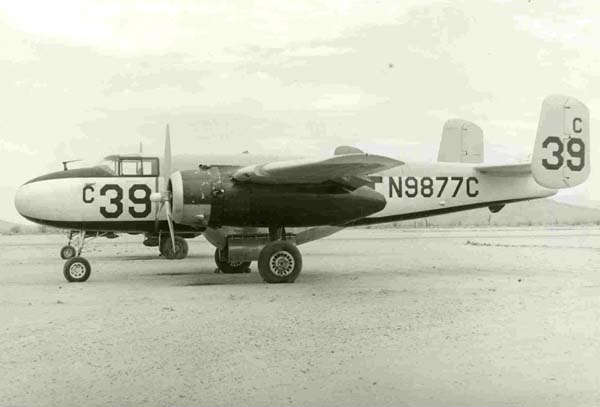
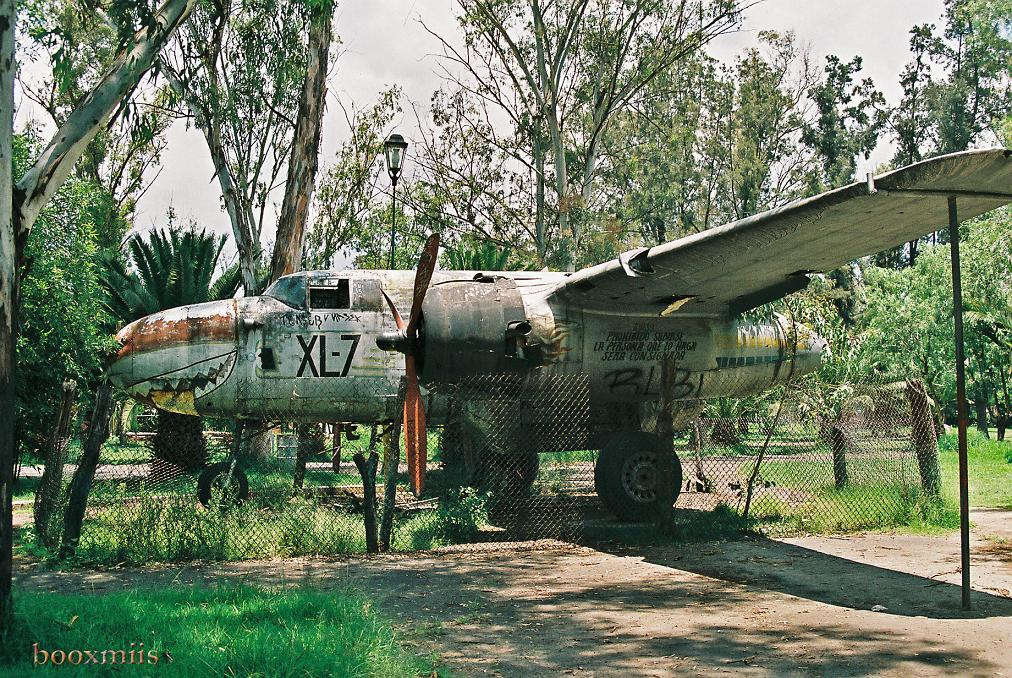
On the other hand, the unmarked aircraft in the park has the somewhat peculiar B-25K radar nose, and it has different high-profile air intakes on top of the nacelles.
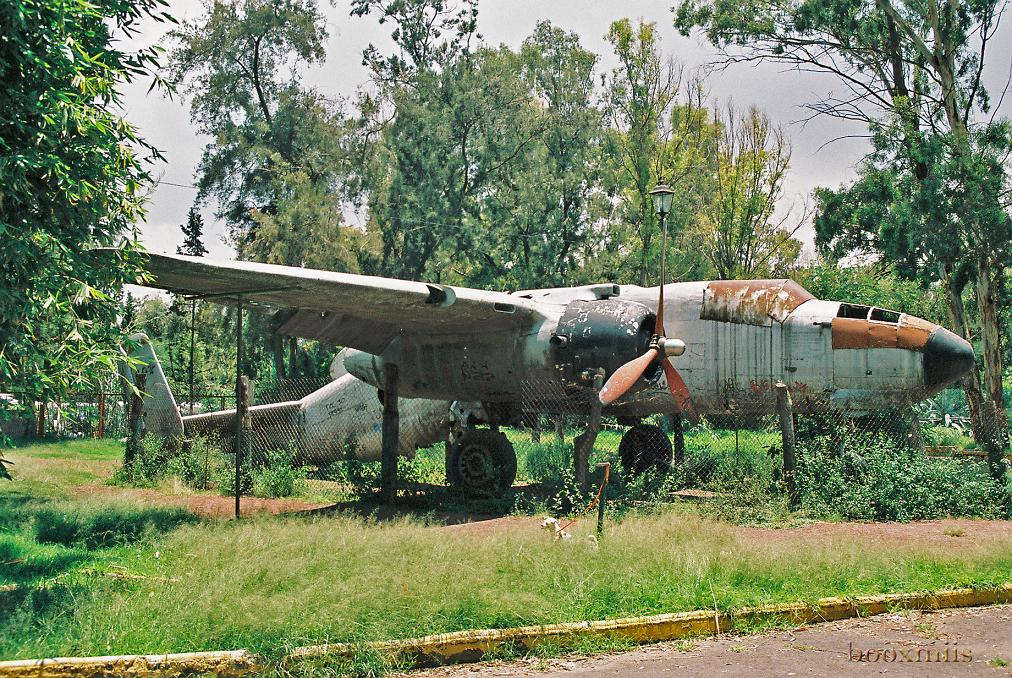
Do you agree with me - again assuming that they are N9877C and N9623C to begin with - that the one marked as "XL-7" must be N9877C and the unmarked one N9623C?
I have not been able to locate a photo of TB-25N N9623C in its civil configuration. But, yep, for what it is worth, I have to agree with Aad. And, looking at the photo of the resulting restored B-25, it would appear that components from both aircraft made it into the resulting Mexican Air Force B-25. And, looking at the picture, it would appear that there might be an opportunity to eventually add a real upper turret, or at least a turret shell, and also the cockpit Plexiglas appears incorrect. Nonetheless, an incredible effort given what they started with. Hopefully, more details will emerge about the actual restoration effort.
- B-25 For Sale: For a cool $1 million, you can pick up B-25H 43-4106 (N5548N), which was listed for sale recently on the Courtesy Aircraft Sales website.
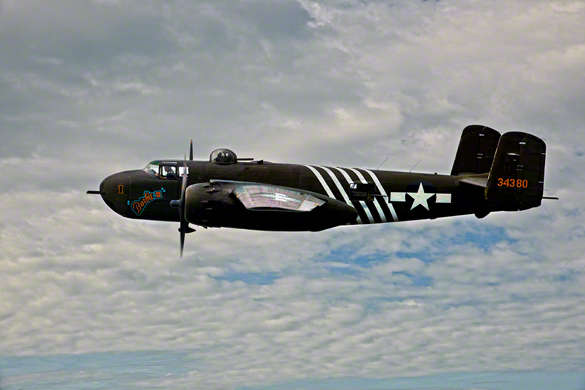
This relatively rare B-25H is currently owned by Historic Flight, but has had a busy past. After its military service ended in 1945, it was used by Bendix for two decades as a test bed for brakes and electronic gear. It was restored as a warbird in the 1980s by the Weary Warriors group at Rockford, Illinois. At that time it gained the paint and markings of Barbie III, which it carries to this day.
The listing shows total airframe time at 3,521 flight hours...that would average out to about 50 hours per year over its seventy-one years since delivery in 1943. Cool.
- North Dakota B-25 Relocated: In September 2014, long stored TB-25K 44-30010 (N9641C) was towed overland from its storage hangar at Whapeton, North Dakota, to the Fargo Air Museum, a journey of about fifty miles.
The B-25K has been owned since 1983 by Tri-State Aviation and/or the late Gerry Beck and held in storage for a future, if never realized, restoration. Not much on the museum website about the acquisition of the B-25; presumably it was donated for display. Further details no doubt forthcoming.
- Christmas Deal: Free B-25 Book: Yep, for the months of November and December, I am offering a free copy of B-25 Mitchell in Civil Service with every copy of the B-17 book Final Cut purchased.
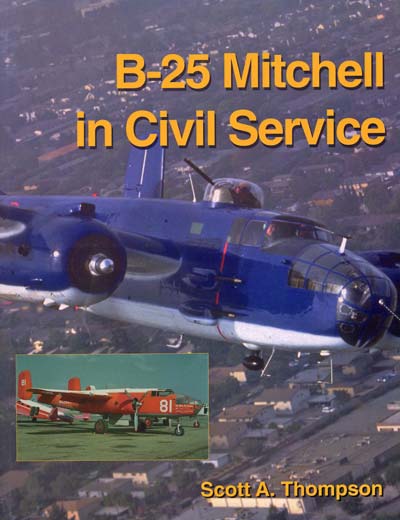
Pretty simple: buy a copy of Final Cut at its normal price of $24.95, and I'll throw in a copy of the B-25 book gratis. You pay nothing additional. Shipping cost is the same. Just order the book. Like magic.
Here is the solution to your Christmas shopping dilemma!!
You buy your wife Final Cut and you get B-25 Mitchell in Civil Service on the side. You don't even have to tell her about your little bonus. Can't lose with that deal...
August 2014
- Super Rabbit Flies Again: Scotty Butler of the Oklahoma Museum of Flying, based at Wiley Post airport in Oklahoma City, reported that TB-25J 44-86725 (N25NA) returned to the air on Monday, June 9, after an year and a half long effort to purchase, move, reassemble, and restore this B-25 to airworthy status after years of uncertainty. The airplane was purchased by Brent Hisey in November 2012 and trucked from Oregon to Oklahoma where it was rebuilt to fly once again.
- Fagen Fighter B-25 Flies Again: TB-25J44-86698 (N325N), formerly known as Sunday Punch and based at Santa Rosa, California, has flown again under new colors after a year long overhaul completed by Aero Trader at Chino. In photos posted recently, the B-25 now wears the name Paper Doll with an AAF camouflage scheme. It is operated by Fagen Fighters at Granite Falls, Minnesota.
The old Sunday Punch was based on a natural metal scheme and the B-25 featured a solid nose, so the airplane now has a completely new look and is expected to be flown often with the museum.
To go down memory lane, here is an old photo of Sunday Punch with its distinctive nose art:
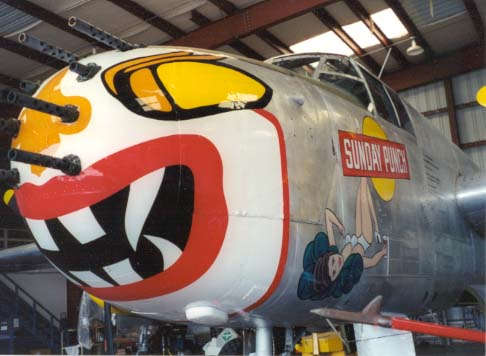
- Update on Sandbar Mitchell Nose Section: In the June update, I identified the B-25 forward fuselage section going into the restoration of the B-25 by the Warbirds of Glory Museum in Michigan as that of TB-25N 44-86844 (N3453G), based upon the long held identity of an airframe that had been long displayed at a Destin, Florida, water park.
Well, Patrick Mihalek, the Museum Director of the Warbirds of Glory Museum, advised me via email that the true identity of this B-25 fuselage section is actually TB-25K 44-30947. He notes that "this B-25 was one of three aircraft, which included 86844 all owned in the late 1960's by a gentlemen who removed all the data plates and flew the same N number on all three aircraft. The only one that survived was 30947 and falsely represented as 86844."
Here is more from Patrick about the basis for this identification, based on some diligent detective work:
We would like to thank Oliver Brown for his extensive research on the true identity of the nose section that is being used to rebuild Sandbar Mitchell.
RCAF 5212 44-30947
The previous owner of this Mitchell was Art Jones, who owned a number of B-25’s and all were registered with a single FAA N number as he was having trouble registering some of the aircraft. He simply removed all the identification plates from the airplanes and put the same FAA N number on all the aircraft. Because of this, the aircraft was grounded at the Lakeland airport in New Orleans.
M. W. Hamilton purchased the aircraft from the Lakeland airport in New Orleans for back ramp fees. The Mitchell was disassembled and transported to Petal, Mississippi, for reassembly at the Mississippi Machinery Museum. Oliver Brown entered the picture in 1986 with the museum. The B-25 had some faded markings – “Canadian Information” and “Marking-Engine Information”. The “5212” referenced was on the outside of both vertical stabilizers. After extensive history from the remaining data tags to the NAA records it is proven that the nose section is not from TB-25N 44-86844 but from an earlier B-25J 44-30947.
To provide a bit of further information, a review of the individual B-25 histories in B-25 Mitchell in Civil Service (an indispensable tool, I might add...), notes that, according to FAA records, Arthur Jones of Slidell, Louisiana, purchased three B-25s in early 1963: 44-30947 (N92880), 44-86844 (N3453G), and 44-30129 (N7947C).
The entry in the book shows the following for 44-30947:
Built as B-25J-30-NC and delivered on Mar. 14, 1945. Initial assignment to Bolling Field, DC as a TB-25J. Stored at Pyote, TX after Apr. 1947. Overhauled at Brookley AFB, AL in July 1951. Modified by Hughes and redesignated as a TB-25K in Nov. 1951. Transferred via the Military Assistance Program to the RCAF in Jan. 1952. Assigned serial as RCAF 5212. Struck off the RCAF inventory in Feb. 1962. Issued provisional Canadian r. of CF-NTP for a one-time ferry flight from Lincoln Park to Calgary, Alberta in Oct. 1961. Sold in 1962 to Columbus E. Woods, Lewiston, MT and registration assigned as N92880. Sold in Apr. 1963 to Arthur Jones, Slidell, LA. No further record. (Some accounts show N92880 to have been RCAF 5237 (s/n 44-86726) and on display at the Reynolds Air Museum in Alberta; however, Canadian records indicate 44-30947 was RCAF 5212 and was exported as N92880. RCAF 5237 is, in fact, on display at the Reynolds Museum but never received either a U.S. or Canadian registration.)
According to its FAA file, 44-86844 was reported to the FAA as being scrapped in 1968, but then was noted as derelict at the New Orleans-Lakefront Airport, LA in 1977 with gutted interior. It was, as noted above, reported as sold to M.W. Hamilton. Then, according to the FAA file, it went to Jay Wisler in September 1997 and was, presumably, sold to the water park operator at Destin, Florida. From the information now available, it would seem probable that the two aircraft identities were exchanged by Art Jones. The crux of this corrected identification can be based on the faded "5212" observed on the vertical stabilizers by Oliver Brown in 1986.
- A Bit of History About XB-HEY, Part One: I had a perfect storm of information come to me over the past few weeks about an obscure B-25, actually VB-25N 45-8843, that I thought it merited a bit of extended attention. For those with only a cursory interest in this, the nutshell version is that this VB-25N, as surplus USAF government equipment, was put to use by a famed sport fisherman to transport sportsmen to Mexico between 1959 and 1967 or so. After an airport accident, the airplane sat unused until is was purchased for the making of the film Catch-22, where it was ultimately destroyed.
Now the longer version, broken into two parts as there are two good little parts of this story. Some of the details behind the first part of this story came to me from Frank McInnis, who sent me an email that contained enough intriguing details to peek my curiosity. So, it begins with Ed Tabor, a retired military pilot who was a bit of a Los Angeles personality in the late 1950s and 1960s. Tabor had a good aviation background flying for an airline in the early post war years, and did a bunch of traveling in Baja California in a PBY in the 1950s. He had a great deal to do with making Baja popular with American fishermen and other sportsmen, and his aviation resources proved useful in an area with few roads. Tabor found the fishing unusually good at Loreto, located on the western side of the Sea of Cortez (aka Gulf of California) on the Baja peninsula. Tabor opened what became one of the first fly-in fishing lodges on the Baja peninsula, that being the Flying Sportsman Lodge near Loreto, Mexico.
To get American anglers to and from his Mexican lodge, Tabor purchased a B-25, specifically VB-25N 45-8843, at a surplus sale at Davis Monthan AFB in April 1959. The airplane was initially registered by Tabor as N8091H and was subsequently modified to carry, reportedly, six passengers, though one suspects it would carry as many passengers as Tabor had to carry. Tabor used his B-25 to transport willing customers from airports in the San Diego and Los Angeles areas to and from Loreto, using a short dirt strip carved out of the desert adjoining his increasingly famous lodge.
On its face, this could not have been a cheap thing to operate even with 25 cent per gallon fuel prices, given the availability of Beech 18s and DC-3s by the dozens, but Tabor eventually purchased a second, as yet unidentified B-25, to add to his fleet. 45-8843 received the Mexican registration of XB-HEY at some point early in its transport history, probably to ease some of his operational paperwork issues. Tabor came to operate other aircraft on his mini-airline including a DC-3, and also a rickety old bus that was used when the air fleet was down. There are a number of stories out there on the internet about customers who used service.
It wasn't long before XB-HEY became a common sight at airports in the Southern California area, and is seen here at Long Beach in 1968 (must have been prior to April) as photographed by Ed Coates.
Frank McInnis was one of Ed Tabor's customers. Frank was picked up at the Mexicali airport by Tabor in one of his two B-25s in mid-March 1967, and flown from Mexicali to Loreto. The landing on the little dirt strip at the Flying Sportsmen Lodge was not successful, however as, to quote Frank, "when landing on the dirt strip in Loreto, it lost the left wheel. The left wing bent up, the prop wrapped around the cowling, and the tail was damaged. It was moved off of the runway and sat as a derelict." So, that turned out to be the end of the flying for that B-25 but, as far as I can determine, this was not XB-HEY but rather the second, as yet unidentified, Tabor B-25.
It would appear, however, that XB-HEY did suffer a serious mishap on the same dirt runway on April 11, 1968, when a landing Lockheed 18, N1940S, entered a ground loop and collided with the parked B-25. XB-HEY suffered a damaged wing among other things, enough to render it non-airworthy to even the most adventurous pilot, so it was also left parked off the runway next to its stablemate in similar disuse and abandonment. Well, at least for a little while.
- A Bit of History About XB-HEY, Part Two: So, the second part of the story about XB-HEY starts with it sitting in near derelict condition on the edge of the dirt runway plowed out next to the Flying Sportsmen Lodge at Loreto. In January 1969, at another plowed-from-the-desert airstrip located at Guaymas, across the Sea of Cortez about 120 nm northeast of Loreto, the final preparations for the filming of the movie Catch-22 were near completion. Frank Tallman had brought seventeen B-25s down from Orange County on or about New Years Day 1969, and the cameras were about to roll. What was missing, however, was a sacrificial B-25 to be used for a crash scene in the film.
Enter one Charles Rector, a somewhat unsung pilot with a whole bunch of knowledge about where airplanes are and what can be done with them. Rector, who began flying in 1924, had a larger than life career in aviation that included, among many other things, running several international airlines, flying support missions in the Arctic while building up the DEW line, ferrying aircraft for the RAF during World War II, flying Mick Jagger around, and flying B-25 and TBM air tankers against fires in the early 1960s. Somehow, Rector got involved with the making of Catch-22 and came to Loreto, acting as an agent for Tallmantz Aviation and Paramount Studios, to take possession of XB-HEY and get it flyable enough to ferry it across the Gulf of California for its film debut and ultimate demise.
As an aside, Ed Tabor later remarked (at least by one source) after the sale of XB-HEY that the sale price "...was the most money I ever made on that damned plane."
The sale of the B-25 was dated January 15, 1969, though the issued check for $4,500 to purchase it was dated a month earlier, on December 19, 1968. So, the deal had been consummated weeks earlier, with Rector becoming the last registered owner of the airplane. The Tallmantz file on XB-HEY noted it was purchased specifically for the crash scene it was later used for. Rector billed the movie studio $2,871 for repairs to get the airplane airworthy, and another $1,000 to ferry it from Loreto to the Catch-22 airstrip on the other side of the Sea of Cortez.
Well, the interesting thing about this whole process is that Craig Thorson made me aware of several photos of Charles Rector rejuvenating XB-HEY on the Flying Sportsmen Lodge airfield in January 1969 in preparation for its short ferry flight. These photos, and a whole bunch of other interesting photos, are available at the San Diego Air and Space Museum Archive flicker page, something any enthusiast could and should spend a bit of time perusing.
Here is the VB-25N during the process, the individual in the photo unknown. The color photo also provides detail of the last, and probably only, civil scheme worn by the airplane.
Here is a shot of an engine run as the airplane is being prepared for flight.
This shot is similar, except it most interestingly shows that second derelict B-25 parked next to XB-HEY. This B-25 remains unidentified, despite my best efforts to track it down. It is not even known if it was Mexican registered, though there are several possible candidates that might fit. More research to be done here. By the way, Frank McInnis reports this airplane remained derelict at the Loreto airstrip into the mid-1980s, parked in the same sad spot. Reportedly, it was cut up at that time and scrapped to make way for some new buildings. So, gone but not quite (almost, though), forgotten.
And here is another interesting photo. I think it depicts XB-HEY after it was flown into the Catch-22 airstrip at Guaymas (note the mountain in the background). It would appear that a very hastily applied camouflage scheme was applied. Was this done to quickly cover the civil paint scheme in case the airplane strayed into camera view during the initial part of the filming? That would be my guess, but the answer remains elusive. The Piper Comanche might have stood out too. Where's the paint gun?
The fate of XB-HEY has been documented on this site, but as a recap, it clearly appears in two scenes: the first scene is the crash landing where it seemingly careens off the runway and explodes in flames as an oblivious Milo Mindenbinder (Jon Voight) and Colonel Cathcart (Martin Basalm) discuss war economics.
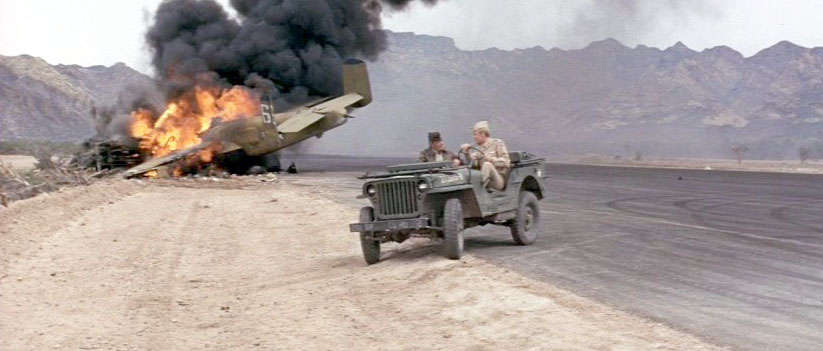
And, the airplane appears in the scene that immediately follows the one above, as the two walk by a derelict B-25. This scene must have been shot at an earlier point in the filming sequence, perhaps weeks or months earlier, because in my photo analysis worthy of the Warren Commission, both are the same airplane and both are XB-HEY and I need to get a new hobby.
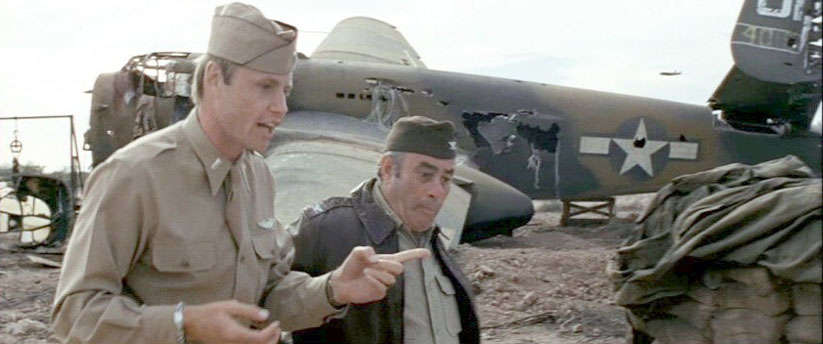
As a post-script, here is a later shot by Stony Stonich of the forlorn XB-HEY lying as nearly scrap, which is about all it was at this point.
When the filming was completed and the airfield cleared and abandoned, a large hole was dug and the remains of XB-HEY and probably a bunch of other airplane scrap and parts, were buried and left behind. And that is the rest of the story, and the end of the story for this airplane. Wait, anyone got a shovel?
- California River Delta Mitchell: In researching some other stuff, I came across this account of B-25J 44-86797 (N3438G) and an account of the brief time it resided on a ranch located in the agricultural rich river delta area located in the middle of the San Joaquin/Sacramento River Delta area west of Stockton, California. I found this account at the site of the California Delta Chambers and Visitor's Bureau. It is apparently an account by a gentleman named Hal Schell:
I remember sitting at the bar at the old Delta Tavern in the hamlet of Holt when farmer Sonny Welser announced he was purchasing a B-25 bomber and having it flown in and parked next to the clubhouse he maintained on his Roberts Island ranch for the Holt Marching and Chowder Society.
Two photos with the website material show this airplane with owner Sonny Welser presumably on the island airstrip, including this photo:This was an invitation-only men’s club. They had great feeds with only the finest foods. They had some high-stakes poker games I am told. They drank a lot of whiskey. I don’t think they ever marched. Sonny liked to declare that they were always available to march in parades in Holt. Holt never had any parades.
I figured the impending bomber purchase was just bar talk. But Sonny built a landing strip out on his ranch, and I expect that it was longer than the deck of an aircraft carrier.
One day at the Delta Tavern bar, Sonny announced the B-25 bomber was arriving the next day. Sure enough, it did. I saw it. I took photos of it. I would judge this to have happened about 1975, give or take a year or two. Although Sonny can remember the bomber’s number (N3438G) he can’t remember just when he bought it or when he sold it.
Surely the club members must have enjoyed it. Although I had been invited, I never did make it to one of the club feeds. I’d judge Sonny owned the aircraft for a couple of years.
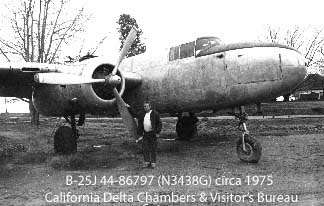
To provide a bit of further information, a review of the individual B-25 histories in B-25 Mitchell in Civil Service (an indispensable tool, I might add...), notes that, according to FAA records, one Milton Welser of Stockton, California, purchased the B-25 in March 1973 and sold it in July 1978 to Richard L.Skadsheim of Modesto, California. It was subsequently parked at the Turlock airport where it received some mechanical work.This B-25 is currently based at Glendale, Arizona, and flies as Old Grey Mare.
June 2014
- Sandbar Mitchell Progress: On May 16th, Martin Filiatrault attended an open house at the Brighton, Michigan, airport conducted by a local EAA chapter and the Warbirds of Glory museum, with the restoration project of TB-25N 44-30733 (N9088Z) front and center. He sent a bunch of photos in showing the current status of the project, several of which we show here.
The heart of this project is the fuselage and wing center section airlifted out of a remote riverbank near Fairbanks, Alaska, in July 2013. The B-25 had been on the sandbar since 1969 after an off-field landing while performing an air tanker mission. Though a large part of the airframe, i.e. the outer wing panels, engines, tail section, and nose section were stripped off the hulk in the intervening years, the Warbirds of Glory museum decided that enough of the B-25 remained to form the nucleus of a B-25 restoration.
As can be seen, a forward fuselage assembly has been located. This would be the cockpit and nose section of TB-25N 44-86844 (N3453G) (actually, TB-25K 44-30947...see August 2014 update above) that, at one time, was displayed at a Destin, Florida, waterpark in what at best could be called an undignified manner. This nose section was offered for sale in 2012 in an ebay auction, and it eventually ended up with the Warbirds of Glory project. By the way, here is a photo of the 2012 offering:
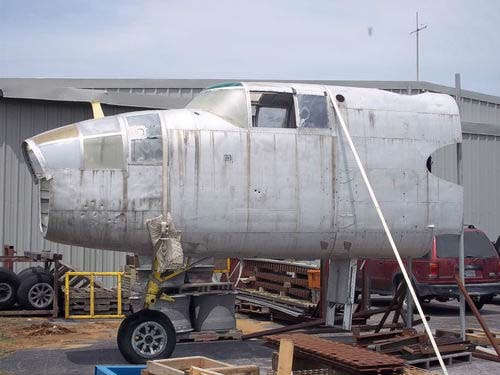
From looking at details presented on the Warbirds of Glory restoration webpage, the May update notes that 'progress has started on disassembling the right side of Sandbar Mitchell’s center section. Both the front and rear main tanks have been removed including the hydraulic lines, fuel lines, and right engine nacelle' with further details and photos noted. Obviously a long term but quite viable project given the proper resources and talent. We follow with much interest and encouragement. Thanks to Martin for sending the photos along.
- FAA Strikes Another B-25: Coert Munk passed to me the information that the FAA cancelled the assignment of N10564 from TB-25N 44-29887 effective April 3. This airplane, once a civil air tanker, was added to the collection of the National Air and Space Museum in 1985 and, apparently, the NASM never canceled the registration. (They've been busy.) So, now it is canceled in the FAA registry clean up. The airplane itself? Well, victim of the black hole of NASM storage, sucked in and never to be seen again.
Coert notes that the information was actually gleaned by Air Britain and I thank him for picking it up and passing it along.
- Heavenly Body Makes A Move: TB-25N 44-30748 (N8195H), otherwise and better known as Heavenly Body, reported for sale in the February 2014 news item below, was purchased by the Erickson group recently and was delivered to the growing museum facility located at Madras, Oregon. The airplane arrived in late May and as been added to a rapidly growing collection.
This ex military trainer, ex crop sprayer, ex Catch-22 veteran was long owned by the late Mike Pupich and was based at Van Nuys for decades, becoming a fixture at California air shows over the years. So, it stays on the west coast and is expected to remain airworthy with its new owner.
- Two NEIAF B-25s in Darwin, Australia: Coert Munk reports that two Dutch ML-KNIL / NEIAF B-25Cs were seen recently by Jeff Deelen in the storage area of the Darwin Aviation Museum.
The cockpit section of N5-133, reported as B-25C 41-12924 is stored in a large container, the fuselage and wings etc are in the open air.
The cockpit section of N5-139, reported as B-25C 41-12913, is stored in the open air.
All remainders are corroded while damage of the battle and crash of the two war veterans is clearly visible. The two aircraft are stored for future restoration.
These B-25Cs were part of a large 1941 order placed by Netherlands Purchasing Commission for 162 B-25Cs to beef up the NEIAF (Netherlands East Indies Air Force) for the impending war with Japan.
- More on Nome B-25: We reported on the remains of a B-25 recently seen at the Nome airport in the May 2014 News.
All available information suggests this is B-25H 43-4108 finally brought in from the cold.Update: this is incorrect information; all indications actually suggest this is NOT 43-4108; had some bad information there. I apologize for any unfounded information that might have been engendered by this report. From my B-25 Mitchell in Civil Service history on this airplane, it is noted as:Built as B-25H-1-NA and delivered on Oct. 29, 1943. Assigned in Nov. 1943 to Ladd Field (Fairbanks), AK for, probably, a winter test series at the Cold Weather Experimentation Center. No further military record noted. Reports that this airframe is an Alaskan wreck and therefore clamed by the U.S. Historical Preservation Museum, Anchorage, AK. R. assigned in 1985 as N58HA but further information not available..
Well, it would appear a bit of further information is available but where it is actually headed remains unknown. For those a bit concerned about the state of the FAA registry, this aircraft's civil registration has already been canceled, so not to worry. - Marengo B-25D: Dean Coryell sent in a couple of photos of some B-25 components he noted in storage at Mike Kellner's place in Marengo, Illinois, the same place where the B-17E Desert Rat is being restored.
After asking Bill Stanczak about it, he provides the information that it is actually the remains of B-25D 42-87558 and the parts consist of a wing, the center section, rear fuselage, horizontal and vertical stabilizers, the elevators, rudders, main landing gear doors, most of the wings, flaps, ailerons, and most of the engine nacelles.
The B-25D was recovered from a field near Dow Field at Bangor, Maine, the same one that held the B-17E that is being rebuilt. The B-17E, B-25D, and several other airframes were obtained as scrap from Dow Field in the early post war years by a junk man. They were disassembled and attempts made to cut up the airplanes, but the two big planes largely survived and are now held by Kellner.
As if Mike and his team didn't have enough to do with the B-17.
- Chino Air Show Mitchells: Roger Cain was kind enough to send in a couple of his great photos of three B-25s seen at the Planes of Fame Air Show at Chino during the first week of May.
First up is TB-25N 43-28204(N9856C), better known as Pacific Princess and flown by Aero Trader's Carl Scholl and Tony Ritzman:
The second is TB-25J 44-30423 (N3675G) flown by Planes of Fame and marked as Photo Fanny:
The last is TB-25N 44-29199 (N9117Z), flying as In The Mood and owned by Bill Klaers of Westpac Restorations.
All great photos and I thank Roger for sending them in.
- That's One Big B-25 RC Model: Patrick Carry let me know about this video showing a very impressive large scale B-25J replica of Kermit Week's Apache Princess. You need to see this to believe it. This thing is bigger than the RV-8 I am building.
They had a Ted Lawson (Thirty Seconds Over Tokyo engine starting sequence) thing going with the left engine but once it got going, it sure flies nicely. These guys appear to be of the German variety and from my pretend knowledge of the German language, I think they keep saying in a very excited manner something like: "Dude, there are egg rolls in my horse nose." Okay, maybe not that, but something like that. Enjoy.
May 2014
- Unidentfied B-25 at Nome, Alaska: Coert Munk sent in two photos of the center section of a B-25 seen at Nome, Alaska, apparently at airport, in April 2014.
Coert noted the photos and mention of the item on Ruud Leeuw's website. The item notes that Fred Wallis returned from travelling and sent him some interesting photos taken at Nome in April. Taigh Ramey looked at the photos and deemed it from a B-25J or B-25H.
I've been to Nome a few times and nosed around the airport a bit and did not see these parts, so I will speculate that this is a wreck recovery in progress. It certainly has that look. The gaping turret mounting hole might be a clue: both USAF B-25s and civil B-25 air tankers, obvious candidates for this airframe's identity, had the turret long removed and the opening patched. The open hole suggest that a turret was installed when the airplane ended up like it is.
No markings are visible, so it probably has been exposed to the elements for many years.
Fred added some more information later to the posting: "It was out on the Tundra for years and they recently hauled it into a museum area." So, my guess a wartime B-25 lost and abandoned. We'll wait for all those wreckchasing guys (you know who you are) to chime in here...
March 2014
- Photo of Long Gone B-25 Surfaces: Mark Leonard sent in an intriguing photo he took of TB-25N 44-30187 (N9170C) along the Pan American Highway in Nicaragua in late July or early August 1963.
Mark reports that he and some friends were driving the highway in the summer of 1963 and, as he recalls, probably drove a mile or so off the highway to find a camping spot for the evening and came across this forlorn and recently disable Mitchell. From the photo, it would appear it was being landed off-airport (Mark reports no airports in the area, and the flaps are extended, suggesting a landing) when it is probable the nose gear collapsed and this was the result.
For those about to pack their bags and hop a flight to Nicaragua for the recovery effort, Mark cannot recall the exact location but, from slide sequencing it would appear to have somewhere between the area of Masaya, Nicaragua (south of Managua) and the Honduran border within a mile or two of the Pan American Highway. To add to the exotic search, they also took a side trip to Granada, which is near the northwest tip of Lake Nicaragua, so it may have been over that way too.
The history of this B-25 comes from the civil histories tabulated in B-25 Mitchell in Civil Service. This particular B-25 was operated by the USAF as a TB-25N through August 1958 when it was placed in storage at Davis-Monthan. It was sold as surplus in January 1960 to National Metals of Phoenix, Arizona, and issued the civil registration of N9170C. It was sold Melvin Weighmann of Tampa, Florida, and then was sold to Tampa Caribbean Enterprises. It went to Angels Aviation, also of Tampa, in May 1962, and then to Air Trading Co. of San Turce, Puerto Rico, in December 1962, and based at San Juan Intl. It was repsossessed by a bank and then went the next month ot Borinquen Imports, also of San Turce. This was the company that held ownership of the airplane when it crashed and reported destroyed in Nicaragua on July 21, 1963. And then, along came Mr. Leonard with his slide camera and this nice image preserved on Kodachrome and now viewed by you fifty plus years later.
As can be seen, destroyed in 1963 was different from what modern standards would dictate. The airplane looks quite repairable by 21st century standards, and it would appear there was little likelihood that anyone was seriously injured in the landing. One would suspect that perhaps the B-25 was involved in some sort of contraband operations given its remote off field operations, but that is pure speculation. Perhaps this photo will shake the trees a bit and more information might just pop out. Thanks to Mark for making this photo available.
- Revised Limited Type Certificate for B-25: Two significant documents have been approved by the FAA in the more technical end of the B-25 airworthiness issues, both brought to my attention by Coert Munk. The first is the revision to the Limited Type Certificate (LTC), AL-2, for the North American B-25.
The LTC is the basic document that allows most civil B-25s to qualify for a FAA airworthiness certificate. Because military aircraft were not designed in accordance with civil airworthiness standards in effect at the time, surplus military aircraft were not eligible for a standard airworthiness certificate from the CAA or, later, FAA. The LTC was a way to bridge the wide gap between the standard and experimental or restricted certificates and allow some surplus military aircraft to be operated as civil aircraft. The original LTC for the B-25 was issued way back in 1946 (following AL-1, issued for the B-17) on behalf of Shell Oil Company. For unknown and peculiar reasons, numerous B-25 variants were left off the original document (and later 1958 revision). The third revision to the LTC, dated January 29, 2014, added all the remaining sub-variants, a total of eight variants including B-25D, TB-25K, and TB-25M. This is actually a big deal because it allows virtually all models of the B-25 to be eligible for the issuance of a limited type certificate vs. the more restrictive experimental and restricted categories otherwise available to surplus military aircraft.
Depending how the initial documents for surplus B-25s were written and what exact subvariant was recorded on the bill of sale determined, up until January 29, if a particular B-25 was or was not eligible for a limited airworthiness certificate. Early surplus sales of B-25Js might qualify, but later improved TB-25Ms might not, though sister ship TB-25Ns did. The B-25C was on the original LTC, but not the B-25D, even though they were virtually identical aircraft separated only by manufacturing plants (a real pain for the several operators of B-25Ds out there not qualified for a limited type certificate.) Now, all surplus B-25s of all variants can qualify for an LTC if they meet the requirements of the set forth.
The LTC is now officially owned by S and R Aviation Services of Chino, which is actually Aero Trader, long the major supplier of B-25 expertise, parts, restoration services, and maintenance to the warbird industry. According to the cover letter issued to B-25 operators, it is revealed the issuance of the revised LTC is the culmination of an eight month effort led by Tony Ritzman. For those wanting to see a copy of the revised LTC, check it out right here.
- B-25 Service Bulletin Issued for Fuel Tank Disconnect: Also issued in late January from Aero Trader was a service bulletin, B-25-002, that allows the wing rear fuel cell(s) and/or the wing auxiliary fuel cell(s) to be disconnected.
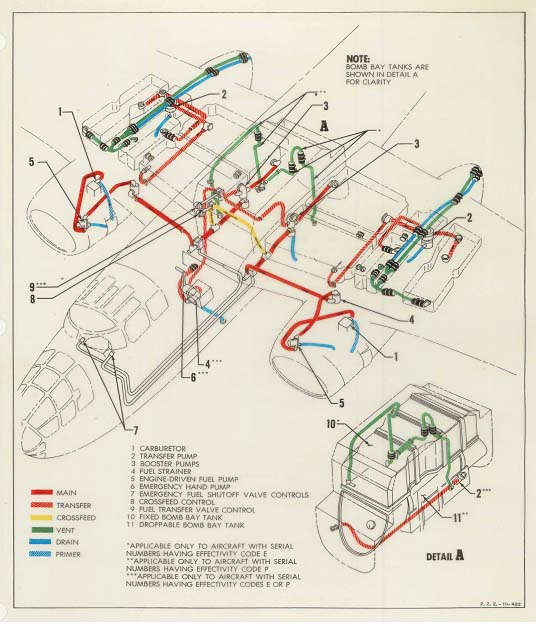
The reason for the issuance of the service bulletin is that many of the self-sealing tanks have deteriorating interiors and the service bulletin provides an engineered and approved method to disconnect such tanks from the fuel system. This allows the continued operation of such B-25s without the expensive task of obtaining new replacement fuel cells.
- Tallmantz B-25s: I had the pleasure of participating in a Society of Aviation History (SAH) presentation on the filming of the movie Catch-22 back in December 2013. Central to the program was the participation of three movie pilots, Stoney Stonich, Dan Hill, and Odell Burton. It was an excellent presentation because of their recollections of the filming. I also had a chance to speak with Odell Burton, a long time Tallmantz pilot, about some of his experiences with the various films he worked on with Tallmantz. He also lent me his scrapbook and these included a bunch of interesting photos, including this one showing both the Tallmantz B-25 cameraships probably circa 1972 or so.
The airplane on the left is N1042B, the main Tallmantz camership. The one of the right is N9451Z, the airplane that replaced Mantz's original B-25H, N1203. The distinctive camera nose is off the B-25 because of the SEEKVAL JOINT TASK FORCE program: the camera nose had a speed limitation imposed by the FAA STC that required the standared GI nose be reinstalled. Odell flew many missions as one of the B-25 pilots for Tallmantz beginning in the early 1970s and extending until the company closed up in the mid 1980s.
- List of B-25s Held on Loan by NMUSAF: A list recently surfaced on a WIX Posting that apparently details in an official manner the entire collection of NMUSAF on loan to other museums and/or groups from its collection, and it includes the USAF unit it is assigned to if applicable. This list includes eighteen B-25s, all of which are on static display. This listing does not include the B-25D, 43-3374, displayed at the NMUSAF main facility at Wright-Patterson AFB, Ohio, Thus, the NMUSAF holds a total of nineteen B-25s. The added column of remarks below are corrections and other information that I have added, and I have edited the listing a bit of ease of reading. There are a few glaring and inexplicable errors.
SERIES SERIAL ORGANIZATION CITY STATE ADDED REMARKS/CORRECTIONS VB-25J 43-4030 ELLSWORTH AFB (SD), 28 BW/MU ELLSWORTH AFB SD Ex N3339G B-25H 43-5103 LACKLAND AFB (TX), 37 TRW/AHMU LACKLAND AFB TX Lackland B-25 is ex CAF TB-25N 44-29835 (N3676G)?? Why misidentified? TB-25N 43-27712 PIMA AIR AND SPACE MUSEUM TUCSON AZ TB-25N 43-28222 HURLBURT FIELD (FL), 1 SOMSG/CD HURLBURT FIELD FL Ex N5256V B-25J 44-28834 GRAND FORKS AFB (ND), 319 ABW/XP GRAND FORKS AFB ND TB-25N 44-28875 GOODFELLOW AFB (TX), 17 TRW/XPR GOODFELLOW AFB TX JTB-25N 44-30363 STRATEGIC AIR AND SPACE MUSEUM ASHLAND NE B-25J 44-30444 MILWAUKEE COUNTY MILWAUKEE WI B-25N 44-30635 CHANUTE AIR MUSEUM RANTOUL IL B-25J 44-30649 MAXWELL AFB (AL), 42 CONS/LGCM-3 MAXWELL AFB AL TB-25N, Ex N9452Z B-25J 44-30854 EGLIN AFB (FL), 96 ABW/MU EGLIN AFB FL B-25J 44-31032 MARCH FIELD AIR MUSEUM MARCH ARB CA TB-25N, ex N3174G TB-25M 44-50493 MALMSTROM AFB (MT), 341 SW/MU MALMSTROM AFB MT Actually TB-25N 44-30493; ex N9451Z B-25N 44-86772 HILL AFB (UT), 75 ABW/MU HILL AFB UT TB-25N, ex N9333Z B-25J 44-86843 GRISSOM AIR MUSEUM PERU IN TB-25N, ex N3507G B-25J 44-86872 ROBINS AFB (GA), WR-ALC/MU ROBINS AFB GA ex N2888G TB-25J 44-86880 THE NATIONAL MUSEUM OF TRE PACIFIC WAR FREDERICKSBURG TX B-25J 44-86891 CASTLE AIR MUSEUM ATWATER CA JB-25J, ex N3337G
February 2014
- B-25 For Sale: In a not unexpected move, TB-25N 44-30748 (N8195H), otherwise and better known as Heavenly Body, has been placed up for sale for a cool $1,300,000. The offering is being made through Platinum Fighter Sales.
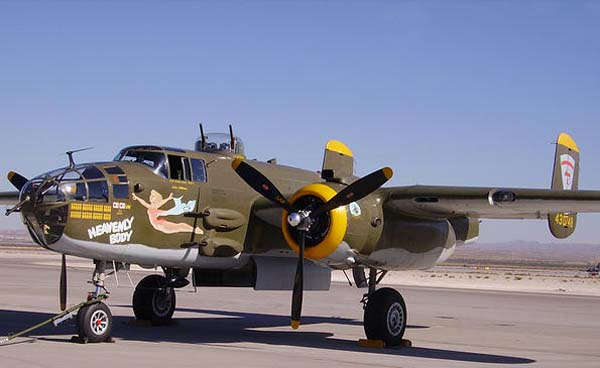
This particular B-25 was a Catch-22 veteran and was purchased off the Tallmantz storage lot in 1971 by Milo Pupich, who put together a sustained effort to restore the bomber to its former glory and keep it airworthy, both goals that were successfully met. The airplane had been based at Van Nuys for several decades and the airplane was a regular at west coast air shows and events up until Milo's passing in September 2012. The airplane was subsequently moved to nearby Burbank as estate details were worked out, and now it is for sale. Nice airplane; the price is a bit surprising but the market is pretty limited so we shall see or, actually, we will probably never know what it actually sells for. But, if you are looking for a good B-25, here is your chance.
- Collings B-25 Leased to Doolittle Museum: An AeroPlane Monthly newsletter reports that the Collings Foundation has leased its TB-25N, 44-28932 (N3476G), also known as Tondelayo, to the Doolittle Center at Vacaville, California, for unspecified terms, to be used by the non-profit museum. The museum does have a web page that details the offering of a Living History Flight Experience on the B-25 from its new base at the Nut Tree airport in Vacaville. The Doolittle Center is raising funds for a major Doolittle themed facility at the Nut Tree facility. Thanks for Coert Munk for this information.
- ebay B-25 Doesn't Sell: If you like browsing ebay for good deals, you might have missed one in December. TB-25K 44-31508 (N6578D), also known as Lucky Lady, was offered on eBay and though it had 21 bidders by the time the auction closed on December 13, it did not meet the reserve price when the bidding stopped at $82,600.
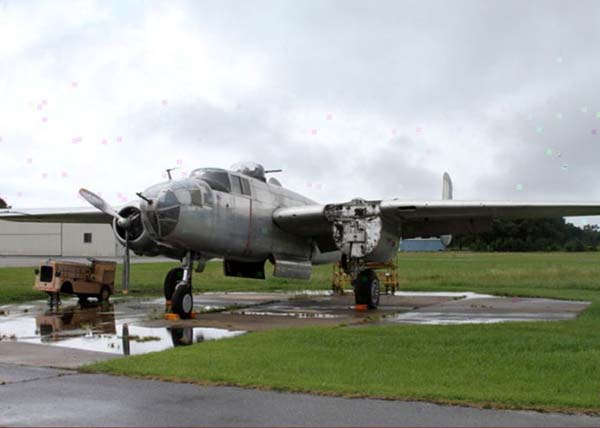
This airplane has been parked at the Franklin, Virginia, airport for at least a decade and, well let's just say, buyer beware. Besides its condition, which speaks for itself, there are also a few questions about title to the aircraft. This was, by the way, the famed Jeff Hawke Psychedelic Monster that filmed The Battle of Britain back in 1968. It has seen better days.
- Another B-25 Registration Cancelled by the FAA: In its continuing effort to clean out the civil registry of long gone or long grounded airplanes, the FAA cancelled another B-25 registration on November 8, 2013, this being TB-25J 44-29128 (N92872). This B-25 went to the RCAF in the early 1950s (as RCAF 5236 and bounced around after being sold surplus in the early 1960s. It ended up displayed on a pole in a city park in Mexico City beginning in 1972. Its current location and condition are somewhat of a mystery but one thing is for sure: it is not an active aircraft in the U.S. so the FAA did its duty. Thanks to Coert Munk for the information.
By the way, Coert came up with a list of 29 B-25 registrations that have been or are being cancelled by the FAA since 2011. Detailed and interesting list; not sure how I can post it on my site so I am thinking, thinking. Okay, I give up.
- B-25 Cockpit Section Missing In Action: Evan Gowdy of the Sandbar Mitchell restoration team sent me an inquiry about any information on the missing cockpit section of B-25J 44-30733. He was looking for anyone hearing of a cockpit section knocking about somewhere. The sale apparently happened in 2009 or 2010 and the cockpit section was moved to the lower 48 states (perhaps California). I confessed I knew nothing but promised to put it here in case anyone knows about this. Let me know if so and I will get the word back to him.
- More on Burchinal B-25: I had a bit on TB-25N 44-29127 (N9899C) back in the September 2013 B-25 News about an ownership and status change. Carl Jenkins emailed me some material about this airplane including two photos he took in April 1976 of the B-25 at the soon-to-be-closed Greater Southwest International Airport at Fort Worth, Texas.
I don't know what it was used for between the time it was sold surplus in 1958 and when it ended up parked here, as there were numerous owners through the years.
Of even more interest, to me anyways, is this excerpt from the Dallas Morning News from October 1, 1976, about Jr. Burchinal's effort to get the airplane ferried out of the airport to meet an impending deadline. It was the last airplane parked out the airport to be flown out. Good stuff, here, and worth a closer look. Click on the image for a bigger view.
Take a read. Thanks much to Carl for passing this along.
- Photos of Brainerd B-25 in 1998: It may be because I've been busy, but I have seen few, if any photos of the B-25 that was displayed at the Paul Bunyan amusement park in Brainerd, Minnesota, between probably the late 1950s and the year 2000 or so. This would be TB-25N 44-29812 that carried the ferry registration of N2854G. Mike Laney, who spends time as a 58th Bomb Wing historian, concentrating on MTO B-25s, sent in these three photos. The first two are of the Brainerd B-25:
A bit of an unusual display but, hey, it's all for Paul Bunyan so we understand. As can be seen, the airplane is marked as Safe Return with a bogus B-25 serial of 43-27102.
The third photo Mike sent in is of the original Safe Return, a 310th Bomb Group, 12th Air Force B-25.
I would imagine there is more to the story than what is presented here, perhaps a local connection. More to come, no doubt.
- Mystery B-25 No Longer a Mystery: The question we posed last month about the identity of a B-25 in some photos sent in by Nick Veronico has been answered with details provided by several readers. It turns out that this B-25, distinctively marked as Luscious Lucille, is TB-25N 44-29887 (N10564) in a scheme it wore in the late 1970s. Here are two photos of the airplane, sent in by John Kerr showing it at Holloman AFB, New Mexico, in September 1979.
According to the definitive B-25 Mitchell in Civil Service, the airplane at that point was owned by DAVU Aviation of Santa Fe, New Mexico. Thomas Strider sent in a link to a excerpt of a book entitled Yardarm and Cockpit by David Allyn that provided a whole bunch of details. Presumably, Mr. Allyn was an owner of DAVU Aviation and in the story, he relates how he purchased the B-25 from Paramount Studios after the filming of Catch-22 for the princely sum of $4,500 in 1971. (B-25s were cheaper back then.) The B-25 flew as Luscious Lulu in the film, with this nose art:
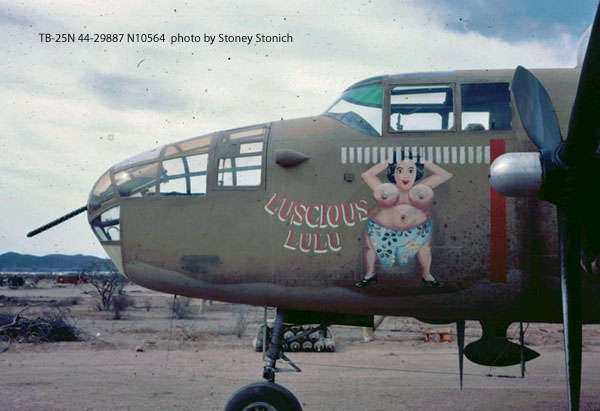
It definitely had an upgrade in the nose art when operated by DAVU Aviation and the name was modified to become Luscious Lucille. No information yet about who Lucille actually was, but the subject of the nose art is now probably pushing seventy, if that helps.
A bit more background on this airplane, though. It was an early B-25 air tanker in the late 1950s, and was the airplane used by the USFS in a study that determined that B-25s were not actually suitable air tankers.
This study was conducted after four B-25 air tankers crashed in July 1960 and, if the standard applied to the B-25 in the study had been applied to the other air tankers then in service (B-17, PB4Y-2, F7F, TBM), there would have been no air tankers. Nonetheless, this B-25 basically went derelict at Hemet, California, until rescued by Tallmantz Aviation for use in the filming of Catch-22. DAVU Aviation owned it from 1971 to late 1979, when it was sold to new owners, renamed Carol Jean with new paint and nose art, and eventually donated to the National Air and Space Museum in 1985. The NASM, not wanting to move too fast on displaying U. S. warplanes, has held it in indefinite storage ever since. Here is the only photo I have of the airplane in storage:
And that is the rest of that story.
January 2014
- B-25 Wreckage Found in Chinese River: Coert Munk passes along an October 28th Daily Mail report of B-25 wreckage located and recovered from the Yangtze River in Zhanghu County, Anqing, in eastern China's Anhui Province. Four Chinese fishermen who were searching for crabs in a river accidentally discovered the B-25 and the wreckage was subsequently recovered. A link can be found here, at least for a while.
The report notes a North American data plate that shows it was built in 1943, and included a serial number. Of course, the serial number itself may have had a fiscal year 1943 serial which means it could have been built in 1944. Date of the accident is unknown, but B-25s operated in China throughout the war and into the post-war period with the Nationalist Chinese Air Force.
- FAA Continues Registry Cleanup: The FAA continues its effort to update the civil registry and cancel long-gone airplanes, Coert Munk notes that B-25J N3398G (44-30761 went to that great registry in the sky on September 30. N3398G had possibly been a USAF training aid but was transferred as surplus to Ed Maloney's Air Museum in 1964 and it received its civil registration at that time. Probably not actually flown, it was reportedly derelict and vandalized by the mid 1970s and subsequently scrapped. The reamins went to Aero Trader at some point, and some parts may have been folded into other B-25 projects. Have to check with Carl Scholl on that one. Anyways, the airplane has not existed intact for many years, and probably last flew in 1949, so the FAA said enough of that.
- TB-25N at March Field Museum in March 1990: Coming on the heels of my September report on the ex MARC TB-25N 44-30210 (N9455Z) being in the Aero Trader hangar awaiting work, is this photo sent in by Patrick Whitham. It shows this airplane in modified remnants of its Hanover Street movie paint scheme. At this point it was displayed with the March Field Museum collection, a bit unusal arrangement that David Tallichet had set up with the USAF base museum.
Big Bad Bonnie later returned to Chino and remained in storage pretty much until this year.
- More Details on TB-25N 44-30210: And, with followup information, TB-25N 44-30210 (N9455Z) that is in the Aero Trader facility was sold by MARC to its new owner, Trent Latshaw, who owns a drilling company in Tulsa, Oklahoma, a few months ago. It has not shown up in the FAA registry yet but will eventually. No announced plans by Mr. Latshaw for the B-25 yet; presumably it will enjoy an IRAN inspection by Aero Trader before moving on to Tulsa. We await new things for a newly flying Mitchell.
- Mystery B-25?? Nick Veronico sent me this photo and we are trying to figure out what B-25 this is.
It is carrying the name Luscious Lucille with distinctive noseart, and it would appear that the face that belongs to the distinctive nose art is sitting in the pilot's seat. Anyone have any specifics here?
In case a more detailed view is needed...

B-25 News Archive
Current B-25 News
2017 B-25 News
2016 B-25 News
2015 B-25 News
2014 B-25 News
2013 B-25 News
2012 B-25 News
2011 B-25 News
2010 B-25 News
2009 B-25 News
2008 B-25 News
2007 B-25 News
2006 B-25 News
2005 B-25 News
2004 B-25 News
1999-2003 B-25 News
Back to B-25 InformationBack to the Main Page
